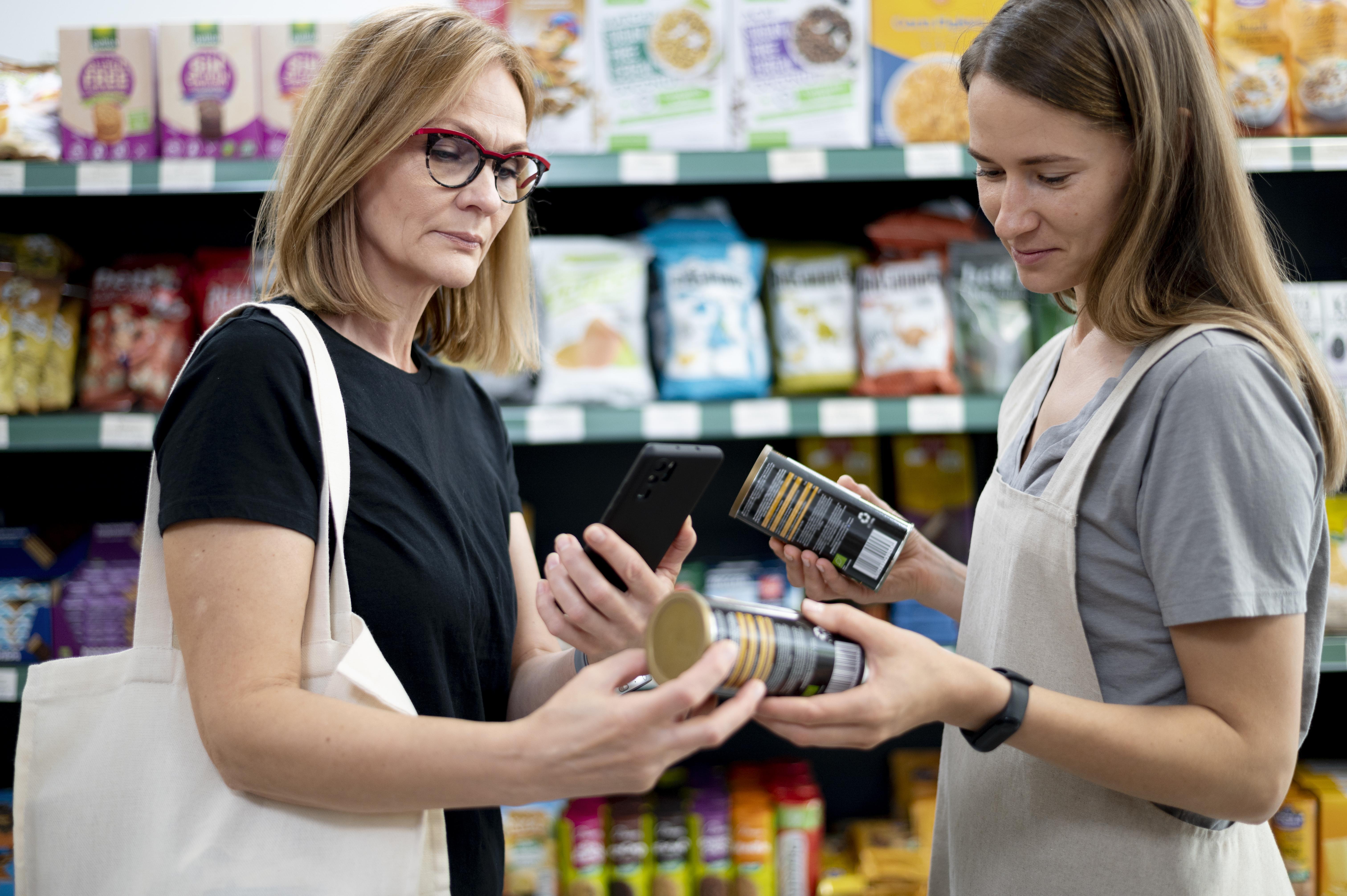Beyond efficiency: A new playbook for value creation in grocery retail
The era of “optimize the store, drive the volume” is over. Discover how forward-thinking grocery retailers transform underused assets into digital ecosystems, and find new ways to drive customer loyalty to fuel growth.
Grocery retail has always thrived on scale and operational precision. For years, larger footprints and getting a million details right every day delivered steady growth. But those engines aren’t firing like they used to.
In 2024, European grocery sales grew by 2.4 percent, barely outpacing food price inflation. Margins are under pressure for most: earnings before interest and taxes now average just 2.8 percent.
It is not surprising that grocery retailers feel stuck. Familiar plays like new products, stores, channels, price offers just don’t deliver like they used to. These approaches were built for a time when everyone shopped in stores. They’re struggling to keep up in today’s hyper-connected, always-on marketplace, where competition is relentless, and digitally empowered customers expect more for their loyalty. Running a tighter ship won’t get shoppers in the aisles or spending more.
But that doesn’t mean all growth avenues are closed, and many grocers have more to work with than they realize. Their vast store network, brand, supply chain, last-mile capabilities, traffic, and loyal customer bases have tremendous untapped potential. For those willing to rethink what’s possible, the door to value creation is wide open.
Traditional retail models have hit their limits
It is no secret that the grocery sector is facing significant challenges. Inflation is at a 50-year high, pushing up costs across food, commodities, energy, and labor. Retailers face volatile supply chains and weak consumer spending—a sharp contrast to the pandemic boom years, which set tough profitability benchmarks now hard to sustain.
Milena Lazarevska, Global SVP of Quick Commerce at global delivery platform Delivery Hero, says, “COVID gave grocery rapid growth potential, but also tough comparables. Now, achieving profitable growth can be challenging, especially in mature European markets.” Profitability relies on expanding basket sizes, but getting customers to buy more is under pressure, from shifting shopper expectations to new store formats and rising competition.
New shoppers, new rules
As Gen Z comes of age, a new type of grocery shopper with different needs and expectations is emerging. They’re digitally native, cook less than their parents, seek on-demand experiences, and are less likely to shop in-store. New entrants are winning Gen Z over with the convenience of online shopping and rapid home delivery. Grocers have little choice but to compete in these areas, even though, as Fabrice Zumbrunnen, former CEO of Swiss retail giant Migros, points out, “it is not profitable.”
Meanwhile, an aging population and more single-person households are quietly reshaping grocery. Traditional pack sizes feel oversized or wasteful for solo shoppers. There’s opportunity in ‘meals for one’ and convenience-driven products, but catering to this sector drives up operational costs, further squeezing margins.

For Zumbrunnen, efficiency and logistics are still table stakes, but no longer guarantee the returns grocers need. Despite these new shopper habits, pricing remains the primary battleground: “If it is off, all other differentiators—sustainability, quality, service—struggle to compensate.”
In this environment, retailers are locked in a race to the bottom. Premium grocers cut prices to keep up with discounters, while discounters boost quality and service to attract a broader audience, blurring format lines. Zumbrunnen says there’s really one way out of this: retailers need to rethink what they can offer beyond the store as the market drifts toward uniformity.
Beyond the store: the many layers of value creation
Zumbrunnen calls it “a bold concept”—the idea that grocers can move beyond selling products to generating new revenue from adjacent service categories. Yet every touchpoint—whether point of sale, online, through apps, loyalty programs, or delivery—has the potential to unlock new and higher-margin opportunities that reflect how people live, shop, and connect.
The term ecosystem is often used in this context, but not every market is ready for an Amazon-level of integrated offerings. Less developed markets have headroom for foundational improvements like inventory management and better assortment planning, whereas European grocers, which optimized long ago, might consider building mini-ecosystems around real customer needs.
Ecosystems can take many forms: loyalty-linked credit cards, home delivery partnerships, in-store financial services, health and wellness offerings. Opportunity pockets may lie in higher quality, premiumizing the product, service, or customer experience. In every scenario, Zumbrunnen says, “the challenge isn’t just offering more—it is offering new. New services, new partnerships, new value.” It involves looking at the company’s unique combination of scale and assets and asking: what else can we do?

The Payoff: Why Value Creation Matters
Value creation at every maturity level, from foundational optimization to advanced ecosystems, enables growth on three fronts:
- New revenue streams: Expansions open new revenue pools beyond traditional sales. Costco is an obvious success story, having launched its Anywhere Visa Card in partnership with Citibank, and expanding into adjacent service areas such as competitive gas stations, pharmacy services, optical and hearing aid centers, tire centers, and travel services. Publicly traded grocers with adjacent-service strategies command higher enterprise values—an average EV/EBITDA multiple of 15.3 versus 10.7 for the sector overall. Bain predicts that, by 2030, half of retail profits could come from “beyond trade” diversification rather than the traditional selling that dominates today.
- Greater customer loyalty: When customers can access multiple products and services under one brand, their lifetime value increases. Each sale paves the way for the next—a multiplier effect that turbocharges results.
- Higher cross-offer engagement: A well-built value creator, such as a best-in-class loyalty program, captures rich first-party data that fuels personalized offers and experiences, while also powering a broader ecosystem of connected services that respond to evolving customer needs. Personalization keeps customers coming back and increases basket sizes.
How to create value differentiators: Lessons from leaders

1. Start with customer trends and reality. Growth follows relevance.
The ecosystem model is a growth path, but it must be focused—don’t add for the sake of adding. The best predictor of success is whether the service proposition meets a real customer need better than anything else in the market. Finding these opportunities requires shifting from a supply-driven mindset (“What do we want to sell?”) to a customer epiphany based around a granular understanding of the customer base (“Where do customers spend money and time, what frustrates them, which needs are currently unmet?”)
Customer data is the starting point, but trend-spotting keeps offers fresh. At Delivery Hero, Lazarevska and her team learned, “there is always growth in expanding and optimizing the assortment to reflect what customers actually want, looking at consumer trends and making sure you have the hip and relevant brands, whether it is the latest startup brands, plant-based options, or meal kits.”
She says that, once you build a loyal community, they’ll follow you in the ecosystem. “Delivery Hero is a platform, and we often have customers who shop for food delivery and then switch to grocery delivery and then other categories like health and beauty or electronics. Then it becomes a nice customer lifetime value expansion and growth.”
2. Audit your strengths and gaps. Build only where you have the right to win.
Grocery brands are well-established—shoppers know what to expect at Aldi versus Edeka, Migros or Waitrose. Every extension should coherently match the brand’s values and purpose, because, Zumbrunnen says, “If your ambition is to be the everything store for everyone and everything, you might be out of the realm of what the customer associates with you.”
Customer analysis may reveal several value-creation opportunities, but the key question is whether your assets and capabilities give you a right to win in that space. Consider which resources (e.g. loyalty programs, data, digital real estate) can be leveraged, and what it would take to deliver new value effectively.
Each opportunity must be evaluated in context: new services should be profitable or enable future monetization, not add strain to operations. Even if returns start small, they should reinforce your broader value creation strategy.

3. Extend your value proposition. Partnerships bring new capabilities and customers.
European retailers can stumble by trying to do everything themselves. “It is different, and difficult, to make new technology or new business models like quick commerce work,” Lazarevska says. “Corporate processes, corporate governance, tolerance for risk and tolerance for investment over a certain period are not matched to what it takes to build out some of these services.”
Strategic alliances, such as with credit card companies or delivery networks, let grocers unlock new value without building everything in-house. In this case, the grocer acts as the core of the ecosystem, earning commissions and integrating services that complement offerings. For example, talabat, one of Delivery Hero’s leading brands operating in the MENA region, partners with Mastercard so customers get discounts, bringing fresh users onto the platform. Lazarevska describes this as “a winning proposition.”
Delivery Hero’s model is built on partnerships. While it began as a disruptor, operating from dark stores, it quickly evolved into an enabler, teaming up with major retailers like Carrefour, Dia, and Spar to provide rapid last-mile delivery through platforms such as Glovo and Foodora. Customers can order groceries from Carrefour through Glovo, for example, to be picked by Carrefour staff and delivered by Glovo riders—often reaching new shoppers who never set foot in the store. “These aren’t necessarily their in-store customers—we run surveys and know they’re new,” Lazarevska explains.
The point here is that partnerships introduce new shoppers to established brands and vice versa, creating a marketplace where every partner benefits and the value multiplies.

4. Get the tech right first. Digital foundations power ecosystems.
In the race to innovate, strong IT foundations are often overlooked. Yet, by their nature, adjacent services demand more from your tech stack, especially when you’re controlling multiple partners in the service chain. Your digital platform must be ready from day one to support growth and integrate new services seamlessly.
Every retailer starts from a different place; as Lazarevska points out, “Problems like carts disappearing too quickly show how far some retailers still have to go.” It may not make sense to pursue additional growth opportunities until the core user experience is healthy, customers are happy, and low-hanging digital improvements are addressed.
With the basics in place, technology becomes a real enabler. You can start collecting richer first-party data, use AI to personalize offers and automate tasks, and add new services that adapt to customer needs in real time—all without being slowed down by legacy systems or disconnected platforms.
5. Activate underused resources. Squeeze more from what you’ve got.
Retailers can unlock new revenue streams by better using existing assets. Loyalty programs are the first—and most obvious—lever. While many grocers run traditional “earn and burn” schemes to boost shopping frequency and basket size, the next step is building programs that engage customers with personalized offers across every touchpoint. Delivery Hero’s approach is a good example: the loyalty programs of its brands cover the entire platform, so customers earn points whether they order meals, groceries, health and wellness products, or toys.
The challenge is keeping these programs sustainable, not just generous at launch. How do you deliver real value to customers, without cannibalizing the revenue those customers were driving? Be prepared to follow Delivery Hero and put prototypes through extensive testing and iteration to find the right balance. Loyalty is a moving target, and programs need to flex as customer needs and competitor offers shift.
A second lever is retail media. Grocers can monetize their first-party data and digital real estate by selling advertising space to other companies, such as consumer products suppliers. With high shopping frequency and rich customer intelligence, grocers offer advertisers both scale and precision—ads reach shoppers when they’re ready to buy, and conversions are measurable.
Larger players are investing in dedicated retail media teams to build this capability, but plug-and-play solutions are making this model accessible for smaller grocers too. As a source of additional profits, Bain has observed on-site margins of 80% and off-site margins of 20% to 30%. Lazarevska says, “Retail media is a big opportunity for Delivery Hero. It is a three-way win between retailers, CPGs, and customers. Brands get to advertise to relevant customers and improve their sales, customers get interesting product suggestions and great deals, and we benefit from the additional revenue.”
Beyond loyalty and media, grocers are also tapping into complementary digital services like banking, insurance, payments, and third-party delivery. These adjacencies are all clear wins for customers and retailers, as long as the service extensions are tightly integrated with the core proposition, adding value rather than complexity.

6. Know your limits. Don’t stretch the brand beyond what customers want.
There’s no shortage of ways to expand beyond the store, but there are real limits to what customers actually want from a grocery brand. Integrating services like credit card partnerships or using loyalty data for tailored delivery can unlock new value, but pushing too far risks diluting your brand and confusing shoppers. As Zumbrunnen warns, “No one wants to book a concert through their grocery app. You’re not WeChat.”
Lazarevska puts personalization in the same bucket. She says that there’s a big difference between seeing a few relevant breakfast options on a food delivery app and being boxed in by a hyper-tailored list. “Retailers end up with suboptimal experiences when trying for hyper-personalization, especially with limited data. Customers want to try different things, so overdoing personalisation makes the experience very narrow.”
Simply beware of overdoing it. Service expansion works when it delivers what customers genuinely need and expect from your brand. Overreaching risks undermining the trust and relevance you’ve worked so hard to earn.
Case study: Rapid last-mile delivery model transforms customer experience for leading European retailer

Migros is Switzerland’s largest retailer, but it is not just big; it is different. As a cooperative, Migros is owned by its 2.3m members, giving it a unique mandate to innovate in ways that serve real people, not just shareholders.
A diversified and vertically integrated group of businesses, Migros has never been afraid to color outside the lines. The group’s business models include cooperative retailing (the core business), e-commerce, own-brand product development, logistics, Migros Banks, Medbase health brand and service entities. Their ex- CEO, Fabrice Zumbrunnen wanted to bring in all of those capabilities to create a network of services connected by customer data.
Learn more: The Corporate Innovation Blueprint, by Migros’ ex-CEO
“If existing retailers miss the opportunities of changing customer behavior, new companies will take that spaces.”

Fabrice Zumbrunnen
CEO of AEVIS Victoria, Ex-CEO of Migros
Loyalty that lasts
Give customers what they want, make it easy to access, and they’ll keep coming back. Even as customer trends change and business lines emerge, the focus on delivering consistent value ensures Migros is the go-to destination on shoppers’ minds. This integrated approach is driving stronger engagement, sustained growth, and a more resilient customer base, even in challenging markets.
Growing beyond trade
It has become a cliché to warn retailers they must diversify or risk being left behind, but there’s truth in it. Resilient companies invest in new growth even when times are tough, knowing that building new businesses takes time and experimentation. But you don’t need to make big adjacent-service leaps or spend heavily to move forward. There’s value in the customer interactions and assets you already own.
Success ultimately hinges on how well retailers balance price competitiveness with differentiated experiences. For Lazarevska, it boils down to this: “As a retailer, you can’t keep cutting costs forever. Partner smart, deliver faster, fix the UX.” And move quickly at it.
Ready to rethink your grocery growth model?
In a world of low margins and uncertain loyalty, we help retailers discover customers’ raw needs and find ways to satisfy them. We identify hidden assets, pinpoint high-potential use cases, and accelerate your path to market with a proven test-and-learn approach.
Our team has helped retailers and CPG leaders break out of the “doom spiral” of inflation, margin pressure, and stagnation. If you’re ready to move beyond incremental change and build long-term resilience, get in touch via the form below.
You may also like
These related articles

Three key growth strategies for grocery retailers in 2025

Finding growth from your core: when to pursue market penetration strategies
